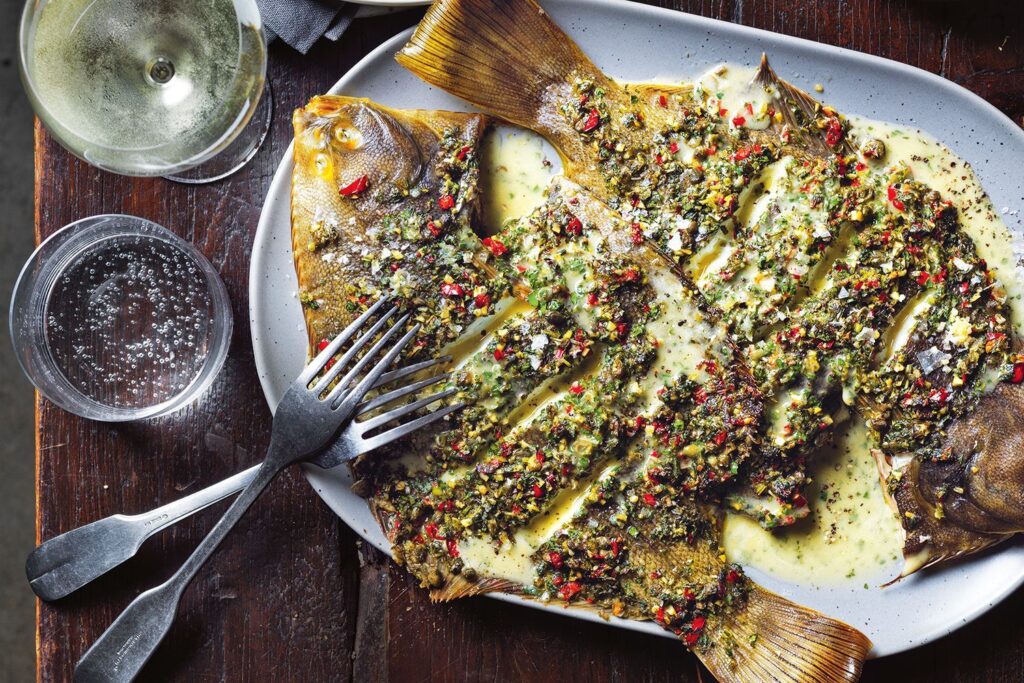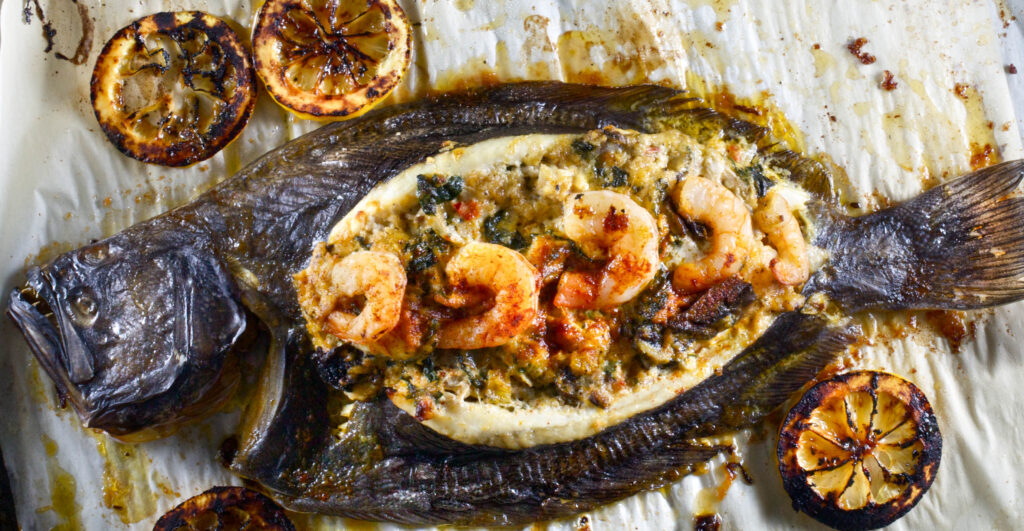Learn how to cook delicious flounder with our easy guide. It doesn’t matter if you’re new to cooking or a pro. You’ll get the key skills to make flounder that’s both tender and tasty. We’ll cover pan-searing and baking to highlight the fish’s natural sweetness and soft texture.

A beautifully arranged kitchen scene with a fresh flounder on a cutting board, surrounded by vibrant vegetables like bell peppers and herbs, a frying pan sizzling on the stove, and shimmering olive oil in a glass bottle. Soft natural light pouring in through a window, highlighting the textures of the fish and the colors of the ingredients.
Learn More Recipe: How to Cook Maja Blanca
Key Takeaways
- Learn effective techniques for cooking flounder to perfection
- Explore a variety of easy and delicious flounder recipes
- Understand the differences between fresh and frozen flounder
- Identify the characteristics of high-quality flounder fillets
- Discover the secrets to achieving flaky, tender flounder every time
Choosing the Perfect Flounder Fillets
Choosing the right flounder fillets is key to making delicious dishes. Whether you pick fresh or frozen fillets affects the taste and texture. Let’s look at the differences and find out what makes high-quality flounder.
Fresh or Frozen: What’s the Difference?
Fresh flounder tastes amazing if handled and stored right. It should smell clean and look firm and clear. Frozen fillets are great when fresh ones are hard to find. Make sure they don’t have any signs of freezer burn or discoloration.
Identifying High-Quality Flounder
Whether you choose fresh or frozen, here’s how to spot the best. Look for fillets that are:
- Bright, with a uniform white or slightly translucent color
- Firm to the touch, with no signs of mushiness or dryness
- Free of any discoloration, dark spots, or unpleasant odors
Keep these tips in mind to pick the best flounder. This way, you’ll make dishes that taste like they’re from a restaurant.
| Fresh Flounder | Frozen Flounder |
|---|---|
| Delicate, fresh flavor | Convenient option when fresh is unavailable |
| Firm, translucent texture | Can become dry or discolored if not properly handled |
| Requires careful handling and storage | Longer shelf life when frozen |
“The true test of a great seafood dish is the quality of the ingredients. Start with the best flounder you can find, and the rest will fall into place.”
Learn More Recipe: How to Cook Maja Blanca
How to Cook Flounder: Preparation and Cooking Techniques
Cooking flounder is a fun and rewarding task. It offers a delicate texture and a subtly sweet taste. Whether you like pan-frying, baking, or sautéing flounder, learning the key techniques is crucial for great results. We’ll show you how to prepare and cook flounder perfectly in this section.
Simple Pan-Frying for Flaky Perfection
One top way to cook how to cook flounder is by pan-frying. This method gives you a crispy outside and a tender, flaky inside. Start by drying the fillets with paper towels and seasoning them with your favorite spices and herbs. Heat a skillet over medium-high, add oil or butter, and carefully place the fillets in it. Cook for 3-4 minutes on each side, until the fish is golden and flakes easily.
- Thoroughly pat the flounder fillets dry before seasoning to ensure a crispy exterior.
- Use a combination of oil and butter for the best flavor and texture.
- Resist the urge to overcrowd the pan, as this can lead to steaming rather than crisping.
If you want a lighter flounder cooking techniques, try sautéing or baking. Sautéing cooks the fillets in a little oil or butter over medium-high heat. Baking puts the seasoned fillets on a baking sheet and cooks them at 400°F (200°C) for 12-15 minutes, or until they’re opaque and flaky.
| Cooking Method | Texture | Cooking Time |
|---|---|---|
| Pan-Fried Flounder | Crispy exterior, flaky interior | 3-4 minutes per side |
| Baked Flounder | Tender, delicate | 12-15 minutes |
| Sautéed Flounder | Soft, delicate | 3-4 minutes per side |
No matter the method you pick, the secret to how to cook flounder well is to handle the fillets carefully and watch the cooking time. With practice, you’ll soon be making flounder cooking techniques like a pro.

A beautifully plated dish of pan-fried flounder, golden-brown and crisp, garnished with fresh herbs and lemon slices. The fish is served on a rustic wooden table, with a side of sautéed seasonal vegetables and a dipping sauce in an elegant bowl. Soft natural lighting enhances the textures and colors of the dish.
“Cooking flounder is an art form – with the right techniques, you can transform this delicate fish into a masterpiece.”
Learn More Recipe: How to Cook Black Pudding
Conclusion
In this article, we’ve taken a deep dive into cooking flounder. You now know how to pick the best fillets and prepare them in various ways. Flounder is a versatile fish that can be cooked in many ways, from simple pan-frying to complex recipes.
These easy flounder recipes and tips are great for both experienced cooks and beginners. They will help you improve your cooking skills. By learning about flounder’s unique taste, you can explore new flavors and dishes. Feel free to try different seasonings, sauces, and sides to find your favorite flounder recipes.
This article has given you the tools to master flounder cooking. Let the fresh taste of this fish inspire your cooking. You’ll impress your loved ones with your new kitchen skills. Enjoy the deliciousness of this versatile seafood and let your creativity shine.
Learn More Recipe: How to Cook Rump Steak
FAQ
What is the best way to cook flounder?
Cooking flounder can be done in several ways, like pan-frying, baking, or sautéing. Each method can make the fish taste great and stay flaky.
How can I tell if a flounder fillet is fresh?
To check if a flounder fillet is fresh, look for ones that feel firm and look clear. They should smell fresh and not have a strong fish smell.
Should I use fresh or frozen flounder?
Both fresh and frozen flounder can be good for cooking. Fresh flounder tastes milder and is softer. Frozen fillets are handy when fresh ones aren’t available.
How do I prepare flounder fillets for cooking?
Before cooking, rinse the flounder fillets under cold water and dry them with paper towels. This makes sure they cook evenly and get a nice crust when pan-fried or sautéed.
What seasonings pair well with flounder?
Flounder tastes mild and sweet, making it great with many seasonings. Try using lemon, garlic, dill, parsley, paprika, or cayenne for flavor.
Learn More Recipe: How to Cook Rump Steak